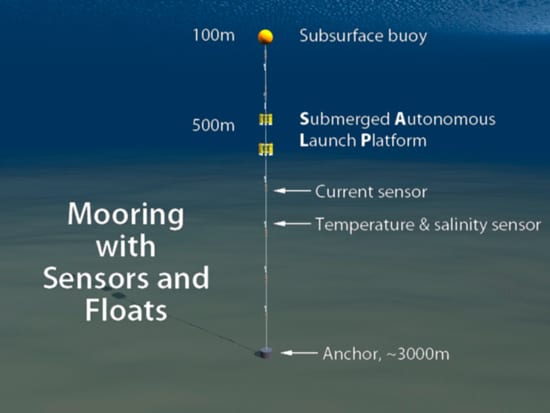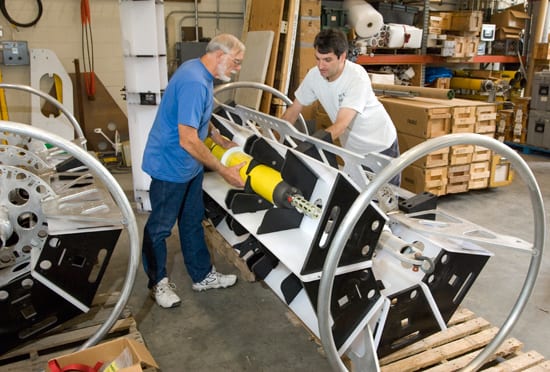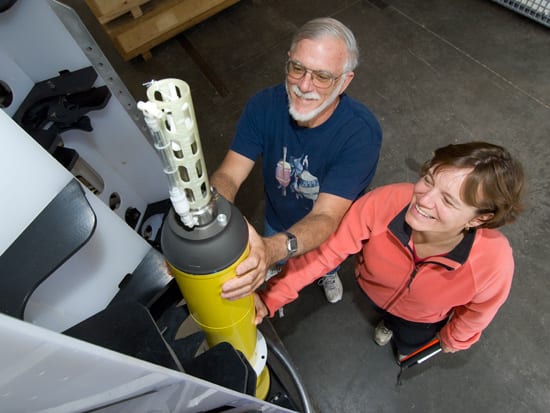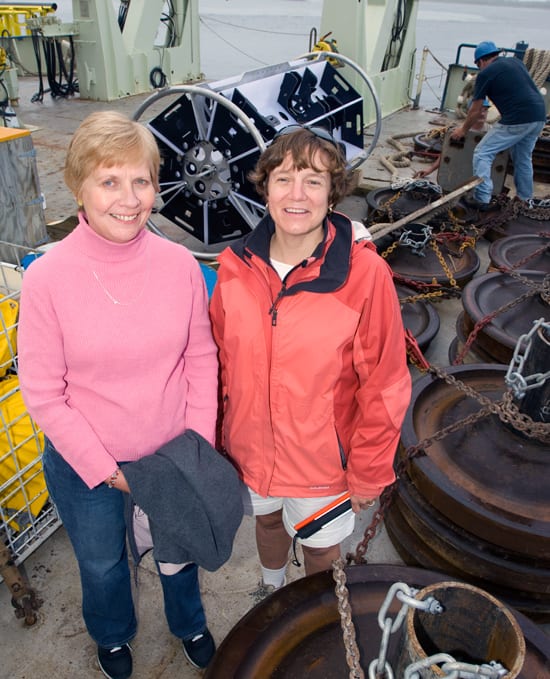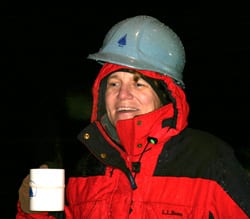Submerged Autonomous Launch Platforms
Amy Bower wanted to investigate an elusive and unpredictable phenomenon in a remote ocean. Off the west coast of Greenland, large, spinning rings of warm water, called eddies, occasionally form in the ocean, like dust devils in the wind, and drift intact for years in the cold Labrador Sea.
“These eddies are small cogs in a big turning wheel,” Bower said. Still, “cogs” are important to understand when the big turning wheel is the ocean’s global circulation, which distributes heat around the planet and helps regulate Earth’s climate (see “A Warm Swirling Eddy in the Cold Labrador Sea”). But how can you know exactly when and where an eddy will form, and how can you track it through a forbidding part of the ocean?
Bower, a physical oceanographer at Woods Hole Oceanographic Institution (WHOI), turned to WHOI senior engineer Jim Valdes, who created an instrument to lie in wait under water. It is designed to detect when an eddy passes by and decide when to launch information-gathering floats that can drift with the swirling eddies like weather balloons in the sky.
In September, they successfully placed two of these instruments—called Submerged Autonomous Launch Platforms, or SALPs—in the Labrador Sea, right “downstream” from the location where eddies often form.
“We’re actually trying to seed floats into a specific ocean feature [the eddies],” Valdes said.
Poised and waiting for launch
The SALPs are attached to a deep-water mooring, which is a line anchored to the seafloor and kept vertical by buoyant floats pulling the line upward—from the seabed 3,000 meters (9,000 feet) deep to 100 meters (300 feet) below the surface (to avoid storms and winter ice.)
Each SALP is an 8-foot-long aluminum frame, fitted with white plastic "carousels"—float launchers full of holes so water can pass through to minimize drag. Each assembly carries six yellow 2-meter-long, torpedo-shaped floats encircling a hub, like bullets in a revolver's chamber.
Bower and Valdes knew (from prior satellite measurements of sea surface heights indicating currents) that eddies pinch off every two months or so from a warm current that hugs the west side of Greenland and encircles the northern part of the Labrador Sea. So they needed two SALPs to hold floats for the 12 eddies they could expect during the mooring’s two-year deployment.
Work on SALPs began in 2001 by WHOI physical oceanographer David Fratantoni and engineers Jonathan Ware, Peter Koski, Don Peters, Dan Frye and Valdes, who designed, built and tested the first SALP. Valdes modified original SALP designs to create one specifically suited for the Labrador Sea experiment.
More WHOI engineers collaborated to put it together: George Tupper designed the mooring, Rick Trask's group built it, and Scott Worrilow attached sensors along its length to measure water temperature, current speed, salinity, and depths. This is the first time the new SALP has been used in an experiment at sea.
Built-in ‘intelligence’
The SALP launchers hold the floats in spring-loaded clasps. A cylinder in the carousel’s center contains the computer, or “controller,” which determines when to release the clasps and launch its floats, one by one.
The SALP controller has two tasks. It detects when an eddy is passing it, by noticing changes in water temperature and pressure. Then it decides on that basis when it’s time to release a float into an eddy.
“The controllers themselves are reasonably intelligent,” Valdes said. “Think of a balloon tied down with a string. When a gust of wind comes along, the balloon blows over. A similar thing occurs with the mooring in the ocean. The SALP on the mooring is at about 500 meters. When the eddy current comes along, the whole mooring deflects to as much as 900 meters.”
Pressure sensors within the controller tell it that it is deeper than it previously was. If at the same time temperature sensors indicate that the surrounding water has become warmer, then an eddy is passing by the mooring. Using both pressure and temperature information to detect a passing eddy is the unique feature of the new SALP.
“When it sees something that it ‘likes,’ the controller activates a circuit that supplies current to a ‘burn wire,’ “Valdes said. “The current causes the wire to corrode rapidly in the salty ocean, and it simply ‘burns’ through. The latch that’s attached to the wire then flips, and a spring-controlled mechanism releases the float.”
“This method of releasing floats is very new,” Bower said. “The carousel mechanism releases when the eddy comes. It’s not a timed release, but instead it’s sensor-driven.”
“We can’t signal the controller to release,” Valdes said. ”It has to do it all by itself, because it’s below the surface, so there’s no way to communicate with it.”
Time to wake up
There’s no direct connection or communication between the float and the controller. When launched, floats are basically rolled out of bed still asleep. They are ballasted to settle to a depth of about 1,500 meters.
“The float is asleep in its frame,” said Valdes. “But the float has an internal alarm clock, which gives it an every-two-hour wakeup call. Somewhere along the way, the float is going to wake and say, ‘Have I crossed 1,200 meters?’ And if the answer is ‘yes,’ it tells the float that it has launched, and it starts its mission.”
Its mission is to rise back up to the surface, measuring seawater properties along the way, and then transmit that data, along with its position, back to WHOI via satellite telephone. The floats repeat the sinking-and-surfacing cycle every five days or so, Valdes said.
The floats will drift with their eddies, rising and sinking, collecting data on conditions within eddies and transmitting them to satellites, until the swirling masses of warmer water dissipate into the Labrador Sea—a process that takes years.
Eddies can be as large as 50 kilometers (27 nautical miles) across, Bower said, and launching more than one float into the same eddy would waste floats. So once a float is launched, there’s a lockout period of 20 days before the next one can be released.
Undersea ‘handshakes’
Valdes programmed one SALP to have a dominant (master) controller and the other to have a secondary (slave) controller. The master releases its floats first and inhibits the secondary one from doing so.
But something could go wrong with the master controller, and engineers are famously concerned with building in redundancy into systems. Throughout the mission, the master constantly assesses whether its sensors are functioning. If, for instance, its pressure sensor fails, it can relinquish control to the slave. How? A connecting cable between the two controllers lets them do what Valdes calls “rudimentary handshaking” every two hours: “The master controller asks the other, ‘Are you still there?’ and the other waves back and says, ‘Yep, I’m here.’ If the slave doesn’t receive a ‘handshake’ from the master in 12 hours, the slave will go into an independent mode.”
Endowing the controllers with intelligence and decision-making capability was “one of the most interesting things” about the project, Valdes said. “You play a ‘what if?’ game. You think how things should ideally work, so that’s how you program it to begin with. But then you say, ‘What if this happens? What sort of reaction should the controller have to that?’ You make a sort of decision tree, with different scenarios of what you’d like to see happen in different circumstances—and all that has to be programmed in.”
“We built in several fall-back scenarios,” Valdes said. If time passes and many floats remain, the master controller “will change its algorithms and be less stringent about its launch criteria,” Valdes said. If all else fails, the SALPs have a timed-release mode to launch floats intermittently.
“This turned out to be a fairly involved project,” Valdes said. “There were electronic controllers to be designed and assembled, programmed, and tested; and mechanical assemblies to be designed, debugged, and tested in water—all these sorts of things.”
After their late September voyage to deploy the SALPs in the Labrador Sea, Bower and Valdes returned to warm labs and computers ashore. On Dec. 8, 2007, with the cold winds of winter rising, the first SALP released its first float into warmer water. Float No. 5266 sank, woke up, and came to the surface, and spent about 20 minutes sending data and checking itself over, before descending again for its next profile. In an e-mail, Bower reported: "It seems to have been released in an eddy core. Yahoo!"
—Kate Madin
Bower's and Valdes' work on the new SALP was supported by the National Science Foundation (NSF). Initial work on the SALP design was funded by NSF and the Office of Naval Research.
Updated: December 10, 2007
The deep-water mooring deployed in the Labrador Sea is a long line stretching from the anchor on the sea floor (at 9,000 feet) to the buoy that holds it upright (300 feet beneath the surface). Sensors fastened along its length measure water properties, and the two SALP launch platforms are attached at around 1,500 feet to detect passing eddies of warmer water. (See animation below by Jack Cook, Woods Hole Oceanographic Institution)
Doing some last-minute checks in the workshop, Senior Engineer Jim Valdes (left) fits a yellow profiling float into the 8-foot frame of a new instrument, the Submerged Autonomous Launching Platform (SALP), as Engineering Assistant Dave Wellwood steadies the frame. This SALP and its twin, visible to the left, were deployed in the Labrador Sea inSeptember. (Photo by Tom Kleindinst, Woods Hole Oceanographic Institution)
Catch! In the workshop, a spring-loaded clasp holding the float is released, and the float is ejected as if a person's two thumbs pushed it away from the frame. Here it falls into Jim Valdes' and Amy Bower's hands. When deployed 1,500 feet under water, the central controller will trigger the clasp and shove the float into a swirling eddy passing by the mooring that holds the SALP frame. (Photo by Tom Kleindinst, Woods Hole Oceanographic Institution)
Kate Fraser (left), science teacher at Perkins School for the Blind in Watertown, Mass., came along on Amy Bower?s cruise to the Labrador Sea aboard the research vessel Knorr in September 2007. As part of Bower?s innovative outreach project with Perkins, Fraser helped interpret the seagoing experience for her visually impaired students. (Photo by Tom Kleindinst, Woods Hole Oceanographic Institution)
On a cold wet night in the Labrador Sea near Greenland, Amy Bower, chief scientist on the research cruise, warms up with cocoa while waiting for the deployment of nearly 9,000 feet of line for her deep-water mooring. (Dave Sutherland, Woods Hole Oceanographic Institution)

